Pizza Rustica is a classic Italian Easter recipe loaded with eggs, cheese, and a variety of meats. This savory pie features an easy homemade crust and is made in a springform pan for an impressive presentation.
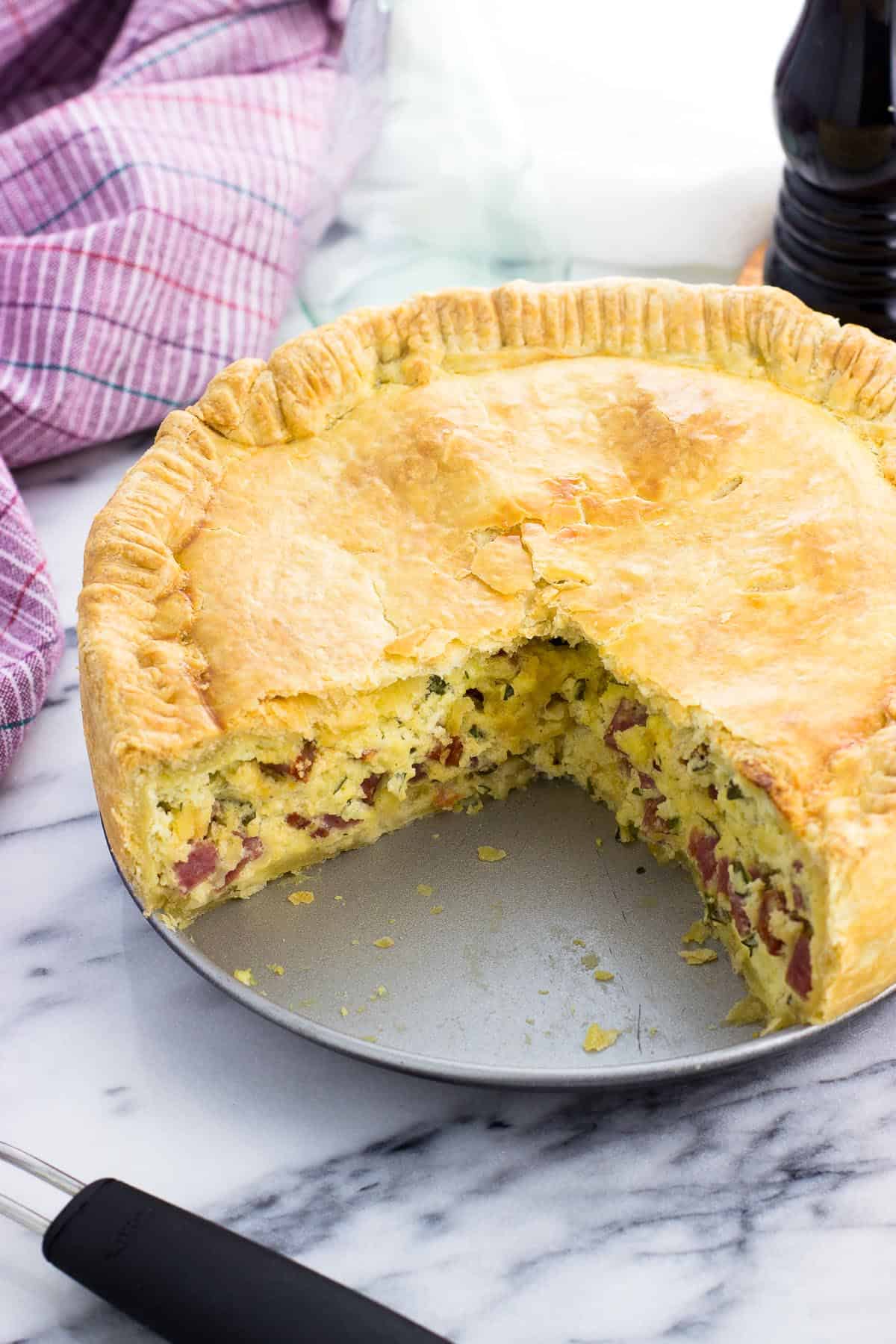
Better late than never, I'm finally getting around to sharing my family recipe for pizza rustica. (See also my family recipe for Italian Easter bread).
Every Easter for as long as I can remember, my mom has made, if you can even believe it, a larger version of this fully-loaded Italian meat pie. She doubled pie crusts and loaded up on enough ingredients to fill a 9-by-13-inch dish in order to feel a large (and hungry) crowd. What looked like an obscene amount of food always had a knack for disappearing by the next day.
Now with a much smaller crowd (or, like this year and last, no crowd at all) the "regular size" pizza rustica will do just fine.
Note: This is a detailed recipe with many ingredients and steps. Fair warning: I'm wordy in this post in the hopes of explaining all of the little details so someone making this for the first time can follow along without issue. Use the table of contents menu below to jump forward to specific sections, or to the recipe card directly.
Jump to:
What is Pizza Rustica/Pizza Gain?
Pizza Rustica, also known as Pizza Gain, Pizzagaina, Pizza Chiena, or Torta Pasqualina ("Easter Pie") among other names, is a savory meat, cheese, and egg filled crusted pie traditionally served on Easter Sunday. Neapolitan in origin, this holiday dish is similar to a supersized quiche/cheesecake mashup with its own unique texture. It's assembled in a 9-inch springform pan to accommodate the extra height, and bakes up into quite a showstopper.
As with many Italian recipes, this isn't the only way to make pizza rustica. The meats and cheeses used can vary, as can the sometimes addition of vegetables such as spinach or hard-boiled eggs. Just like in treats such as cucidati/cuccidati, everyone does it a little differently (even the spelling).
It was interesting to research other takes on something I've been eating all my life. No way is wrong, just don't eat it on Good Friday like a *large online food publication* suggests is traditional if you're abstaining from meat during Lent. 😉
While this recipe is how my family makes it, I've noted below the different areas with wiggle room for you to make it your own.
Recipe Ingredients
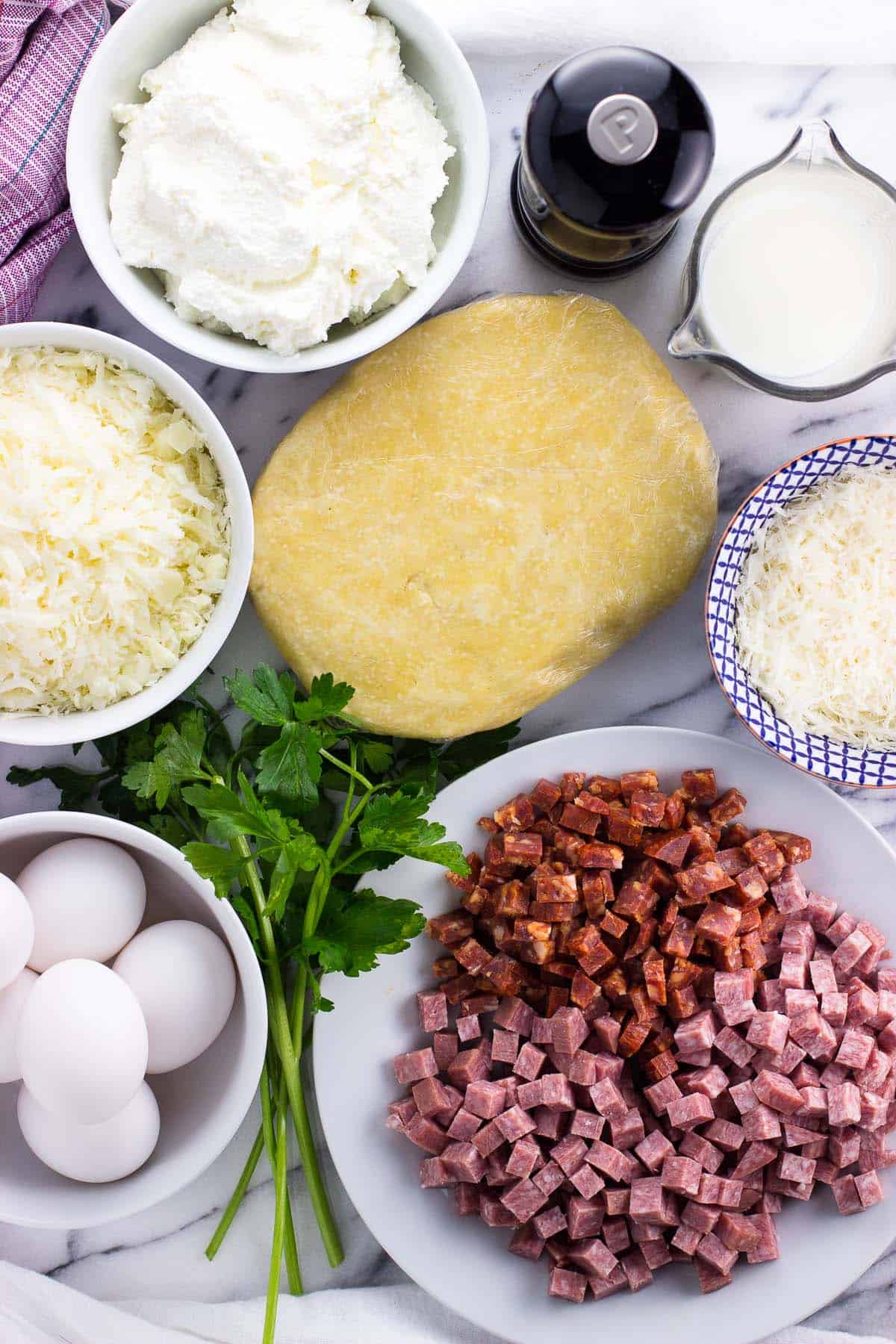
There are four main components of pizza rustica - crust, eggs, cheeses, and meats. This recipe is not for the faint of heart and unlike many of my recipes, doesn't really have any room to be lightened up. It strongly leans into that once-a-year holiday comfort food title.
Pie Crust: Simple ingredients here - all-purpose flour, unsalted butter, eggs, salt, and cold water. The butter brings a classic pie crust flakiness, while the eggs help produce a smooth and strong dough that can stand up to the hefty filling.
Eggs: You'll need nine. Six in the filling, two in the crust, and one for an egg wash. The eggs in the filling are separated, which helps produce a light and fluffy texture that isn't overly dense.
Cheeses: Ricotta, mozzarella, and Parmesan are all added to the pizza rustica filling. I use whole milk ricotta here as it's creamier than part-skim and adds to the semi-luxe, special occasion food vibe. In place of Parmesan you can use Pecorino Romano.
Meats: My family always uses salami for pizza rustica, though other versions include other meats. I've taken to including an equal mix of three salami products: hard salami, Genoa salami, and spicy sopressata. Twelve ounces of meat in total is recommended, so feel free to use just one or two salami varieties, or sub in portions of cooked and crumbled Italian sausage, thickly-sliced prosciutto, or diced pepperoni.
Everything Else: My version of pizza rustica also includes one-half cup of milk to help lighten the texture, chopped fresh parsley, and ground black pepper. Notice that salt is not added here as the meats and cheeses provide enough. There's also salt in the crust.
Step-by-Step Instructions
Prepare the Crust
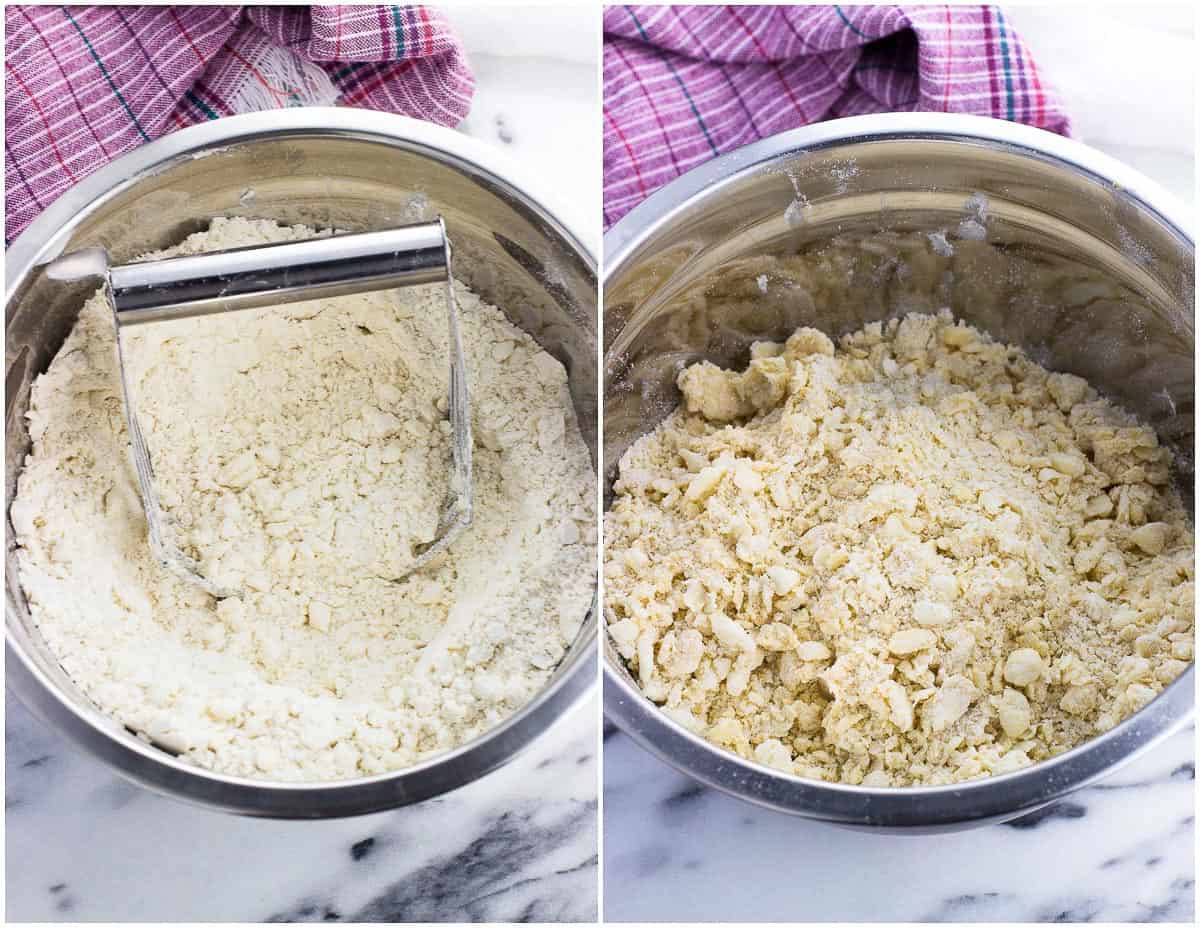
- Dry ingredients and butter - Whisk together the flour and salt, then cut in the small-cubed butter using a pastry blender or two forks. Aim for the butter pieces to get down to around the size of a pea or a pencil eraser, which is usually referred to as a coarse crumb consistency. That's pictured on the left in the photo above.
- Work in eggs - Form a well in the center of the flour mixture. Beat two eggs in a separate bowl and then pour them into the well. Using a fork or a spoon, start to stir and work the eggs into the crust mixture. It won't come together into a ball yet, rather the egg will moisten everything and the crust will form larger pieces and begin to look a little shaggy. That's on the right side of the photo above.
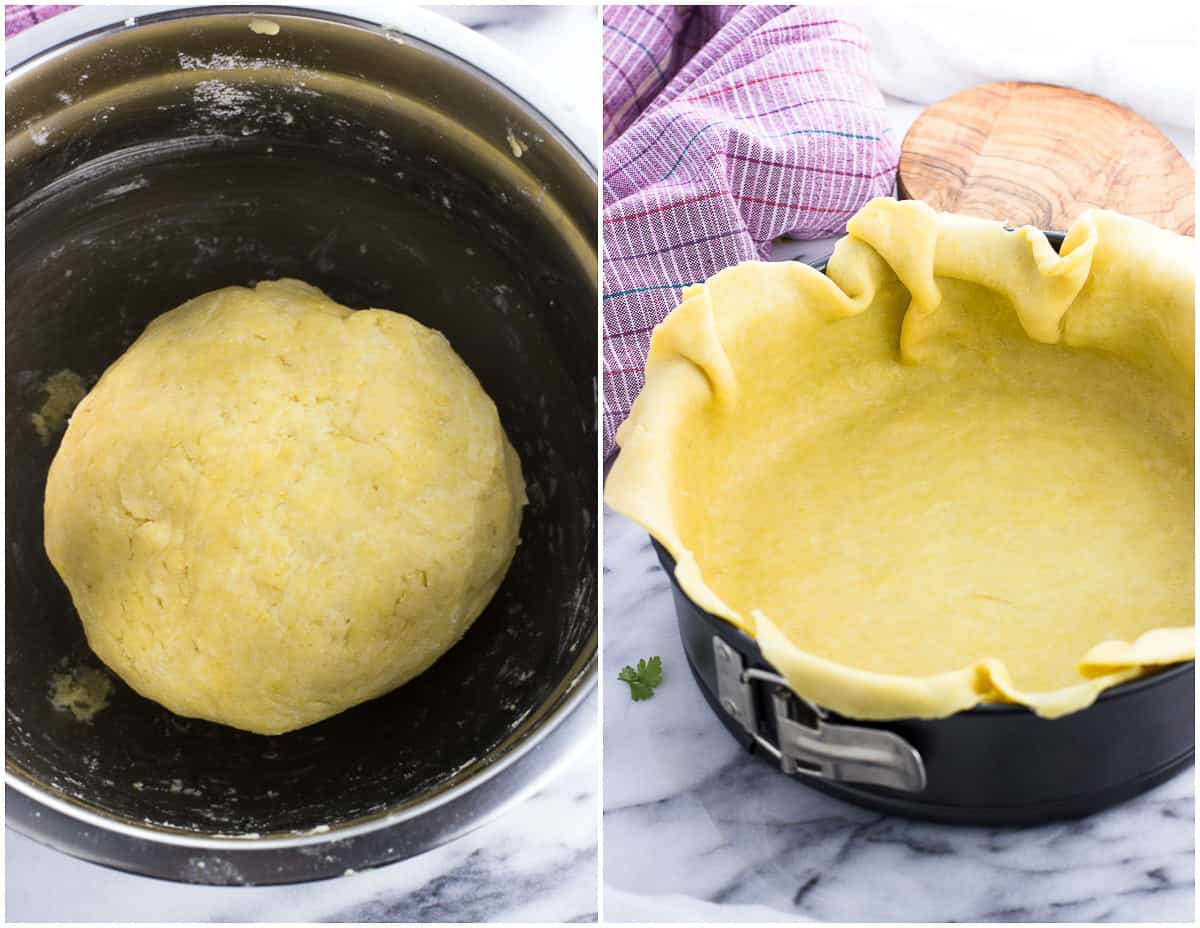
- Add water to form dough - Mix in chilled water one tablespoon at a time until the dough can form a cohesive ball. Go slow here and add the water a little at a time as everyone's conditions differ and your crust may require less or more. Too little water and the dough will be dry and crumbly, while too much will lead to a sticky dough that's difficult to handle. I usually end up using somewhere between three and four tablespoons of water during this process.
- Chill then roll out - The dough needs at least one hour to chill in the refrigerator to firm up, so press it into a flattened disc (this shape helps it chill more evenly versus a big lump), wrap it in plastic wrap, then stick it in the fridge. More on the shaping of the crust further down.
Towards the end of the dough chill time is a good time to begin the process of making the filling.
Mix the Filling
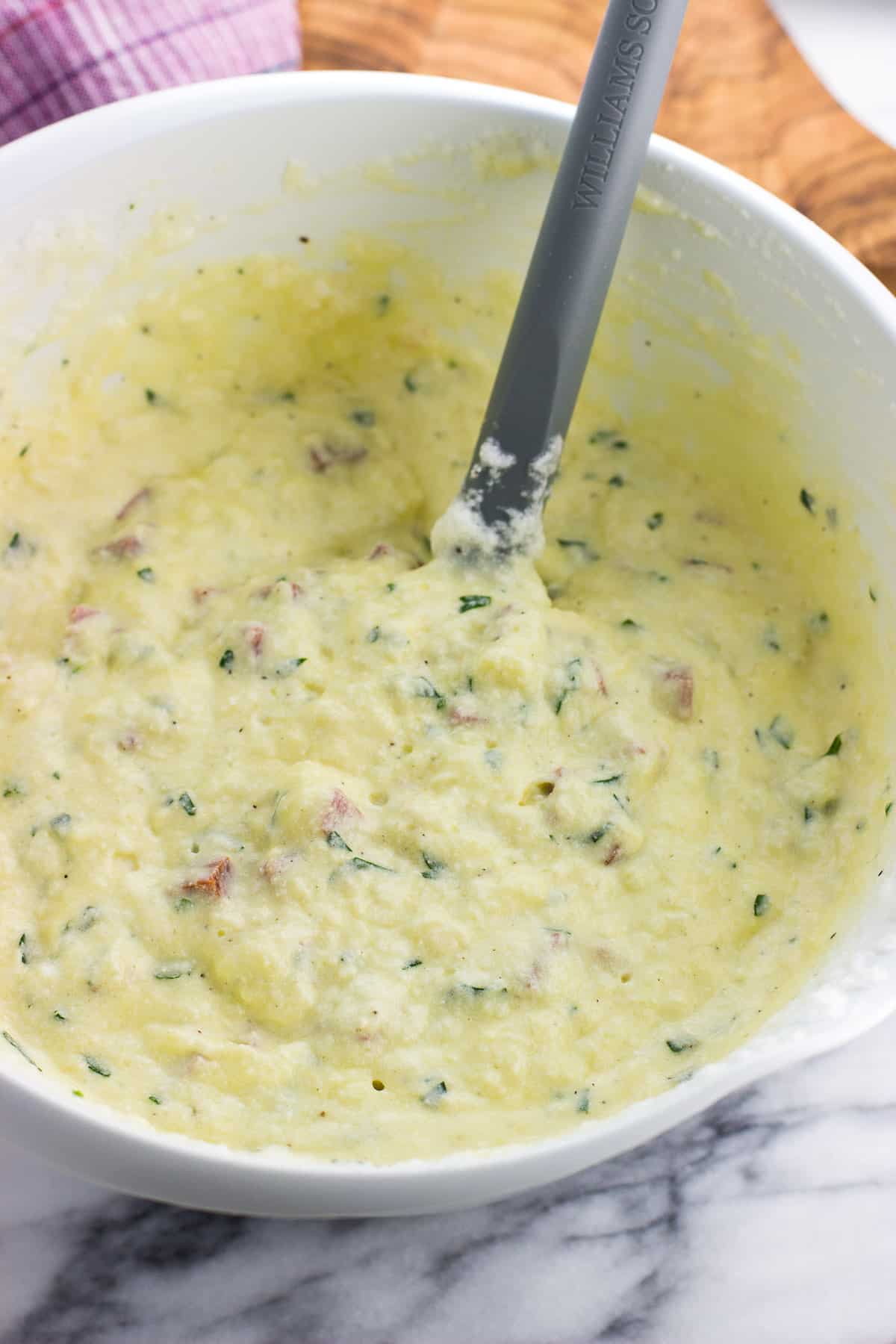
Something that sets this pizza rustica recipe apart from others out there is separating the eggs. While separating the eggs is more work, this step really helps to create a fluffy filling consistency that ends up lighter in texture than you might think possible given these ingredients. I wouldn't skip it.
- Separate eggs - Add the yolks to a large mixing bowl and add the whites to the bowl of a stand mixer or other mixing bowl.
- Mix - Add the ricotta, shredded mozzarella, milk, Parmesan, parsley, and pepper to the bowl with the egg yolks and mix everything well. Stir in the cubed meat.
- Whip and fold in egg whites - Use an electric mixer to whip the reserved egg whites until stiff peaks form. This stage is reached when you can lift out the beaters and the egg whites stand up. Fold the whites into the bowl with the rest of the filling ingredients.
Assemble and Bake
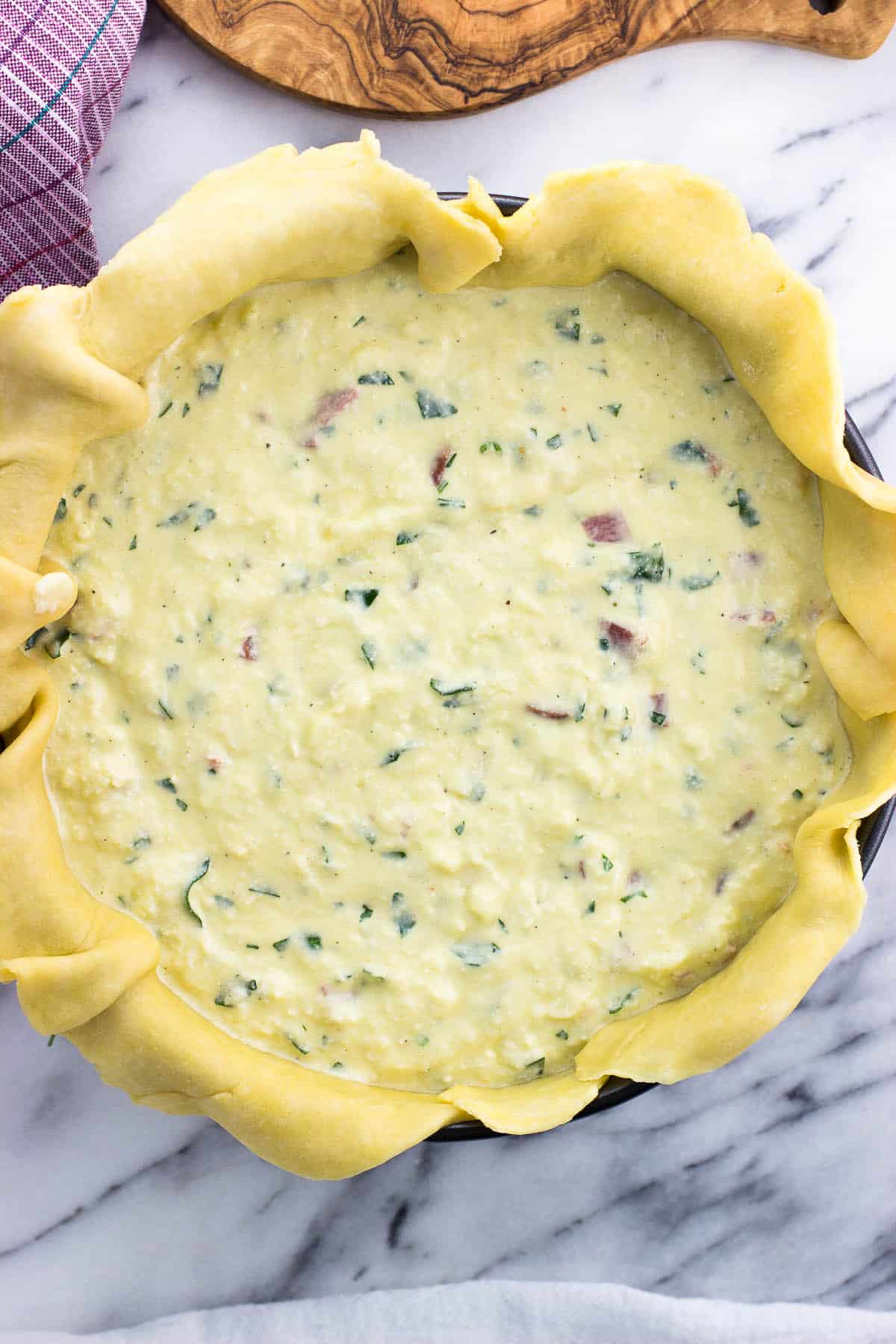
- Roll out the dough - Sliced the chilled dough into two portions: a larger one about two-thirds of the total, and a remaining one-third. Working with the larger piece first, roll it out onto a lightly floured work surface until it reaches about between 15 - 16 inches in diameter and one-eighth inch thickness. You shouldn't need too much flour as the dough isn't very sticky at all and the eggs give it a strong stretchiness.
- Assemble - Lay the dough gently over the greased springform pan, trying not to stretch it, and gently press it flat along the bottoms and sides, leaving a few inches of overhang. Pour in the filling, then roll out the second piece of dough into a 9- to 10-inch circle. Lay this on top of the filling, then fold in the overhang dough pieces and press to join the two pieces.
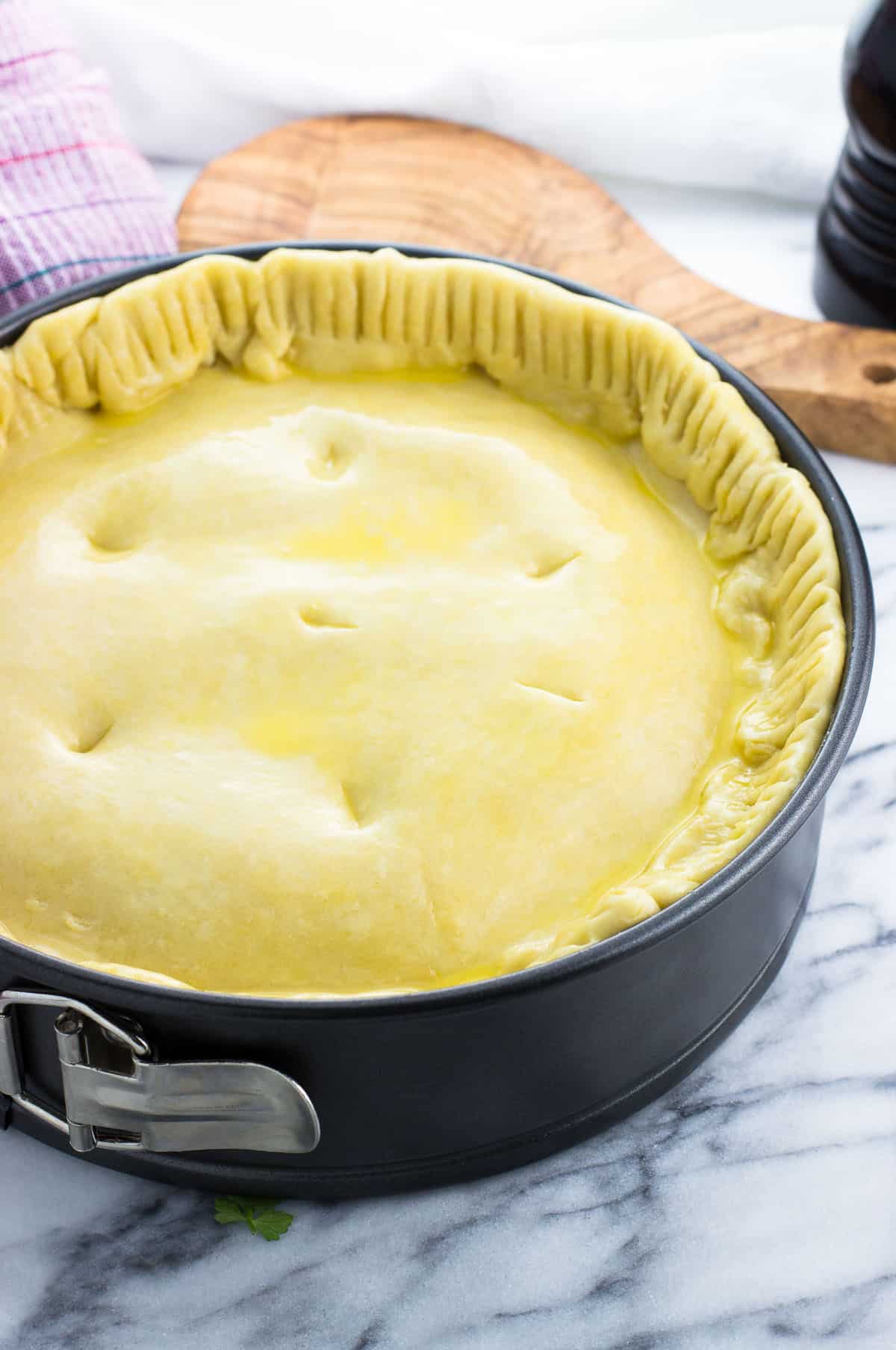
- Crimp crust and vent - Press the tines of a fork into the joined crust, then slice a few slits into the top crust.
- Egg wash - Beat it in a bowl with two teaspoons of water, then brush it onto the entire top surface of the pizza rustica. This will help the crust turn nice and golden brown.
- Bake - Bake it for an hour (or longer) until the pizza rustica is a deep golden to golden brown color.
An Important Tip
After smelling the aroma of the pizza rustica baking for so long, it will likely be hard to resist the temptation to dig into it right away. Please don't do that! Slicing into it when it's too warm will cause the filling, even when fully cooked, to mush out in a sloppy way. It needs a serious cool time in order to solidify and firm up to produce even slices.
I recommend allowing the pizza rustica to cool for at least 45 minutes before slicing into it. The good news about a dish like this is that pizza rustica is wonderful to be eaten warm or at room temperature. You can place it in the refrigerator for a bit to speed this process up without it becoming too cool.
Make-Ahead Instructions
I highly recommend making pizza rustica the day before you want to serve it. This recipe is just about the opposite of quick and easy, and requires sufficient cooling down time once all is said and done.
Fully bake the pizza rustica the day before, leaving it whole to solidify completely. On the day of, place it in the oven to heat thoroughly, tenting the top with aluminum foil to prevent it from browning further.
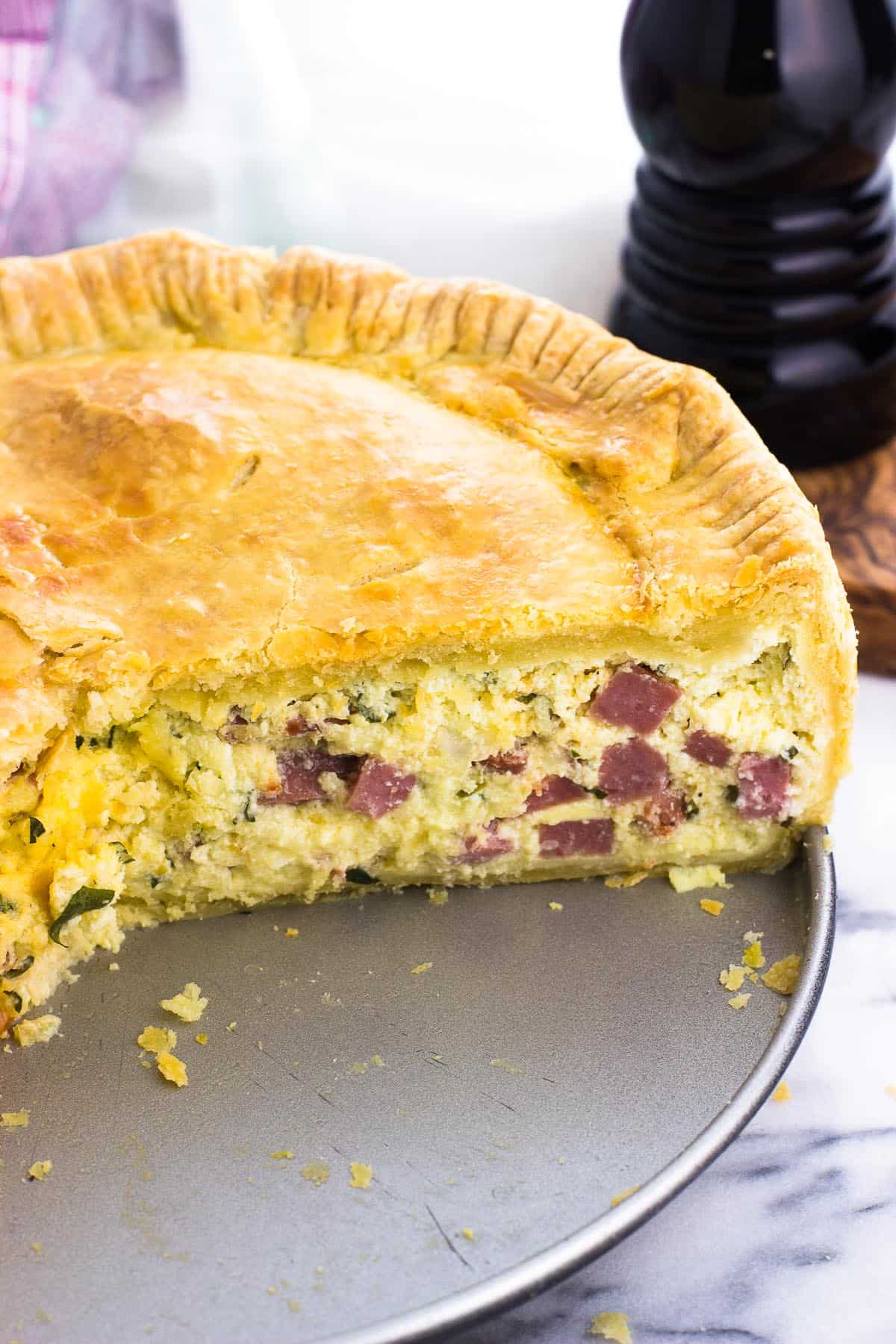
Additional Tips and Tricks
- Deli Counter Tip - If buying salami from the supermarket deli counter, ask them to slice it to "dinner cut" thickness. This is around one-quarter inch and makes cubing the salami really easy.
- Quality Ingredients - I find the pay off worth it to choose high-quality ricotta and Parmesan/Pecorino. My favorite easy-to-find ricotta is Galbani (I have no relationship with them), while I grate/shred a wedge of Parmesan or Pecorino. Don't go for the shelf-stable canisters of Parmesan here as they're lacking in flavor.
- Storage Instructions - Wrap leftover wedges in aluminum foil or plastic wrap or place in an air-tight container and refrigerate for up to 3-4 days.
- Freezing Instructions - Pizza rustica freezes very well. Cut into wedges, wrap in plastic wrap, and place in air-tight bags or containers in the freezer for up to 3 months. Remove the plastic wrap and reheat in the oven, covering the top with aluminum foil to prevent the crust from browning too much.
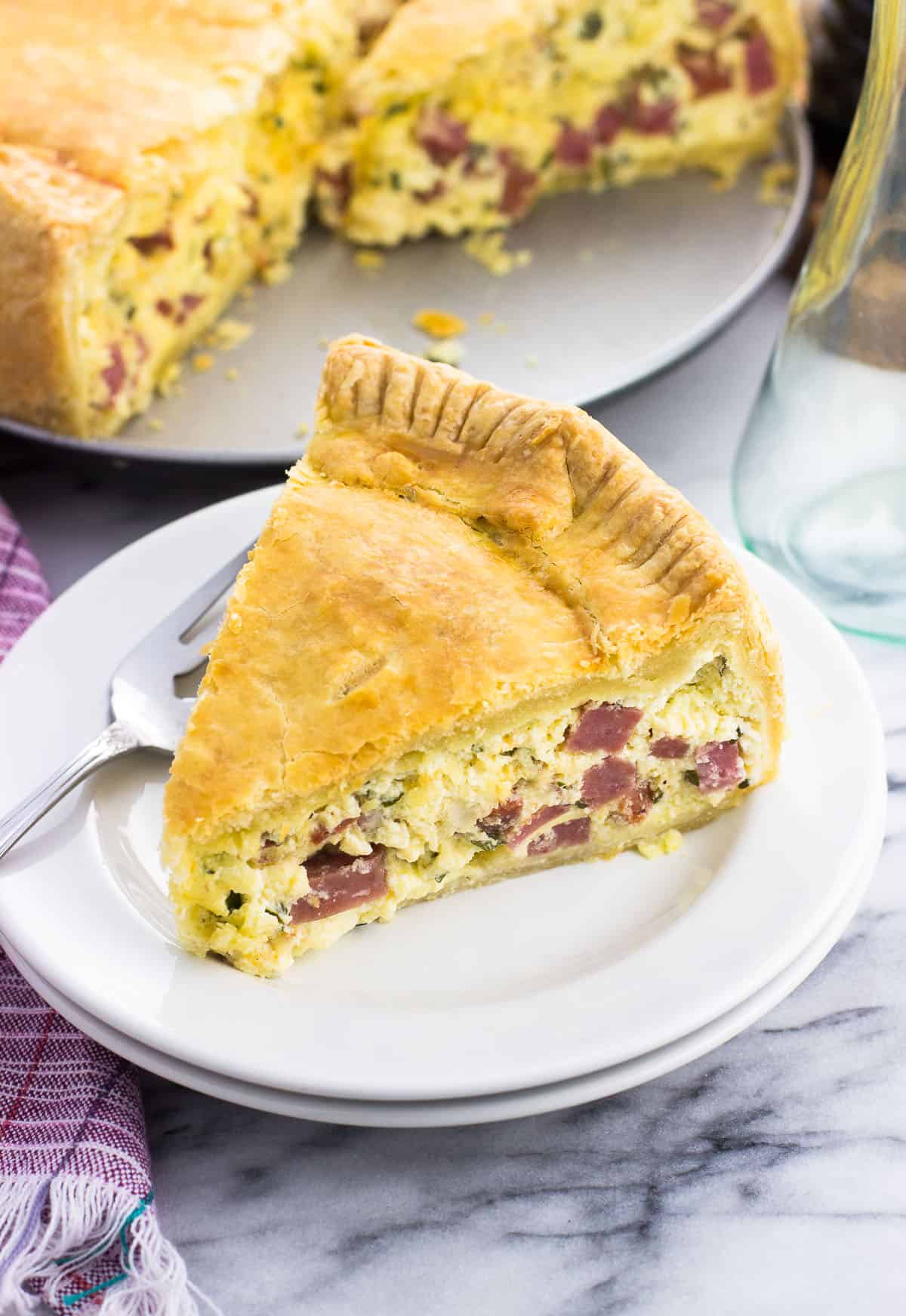
More Italian Easter Recipes
- Always a favorite appetizer for holidays: Italian stuffed mushrooms. My family recipe is meatless.
- We traditionally dig into these on Christmas, but I would never turn down Italian stuffed artichokes any day of the year.
- Struffoli is another big Christmas recipe, but many families also make a batch to enjoy around Easter. This recipe turns simple ingredients into a honey-kissed treat.
- Who doesn't love Italian cookies? Italian anise cookies, pizzelle, pignoli cookies, florentines, Italian sesame cookies...it's hard to pick a favorite.
If you’ve enjoyed this recipe, I’d love for you to leave a star rating in the recipe card and/or a comment review below!
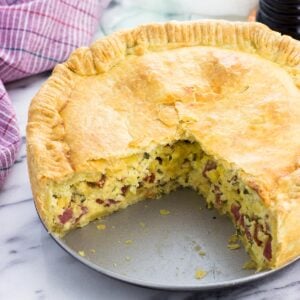
Pizza Rustica (Italian Easter Pie)
Ingredients
Crust:
- 3 cups (368g) all-purpose flour
- 1 teaspoon salt
- ¾ cup (170g) unsalted butter chilled and cut in small cubes
- 2 large eggs beaten
- 3 to 4 Tablespoons chilled water
Filling:
- 6 large eggs separated
- 15 ounces ricotta cheese whole milk recommended
- 8 ounces mozzarella cheese shredded (about 3 cups)
- 4 ounces milk (½ cup) any variety
- 1 ½ ounces Parmesan cheese shredded (about ¾ cup) or Pecorino Romano
- ¼ cup chopped parsley
- ½ teaspoon ground black pepper
- 4 ounces hard salami cubed (about ¾ cup)
- 4 ounces Genoa salami cubed (about ¾ cup)
- 4 ounces sopressata cubed (about ¾ cup)
Assembly:
- 1 large egg beaten
- 2 teaspoons water
Instructions
Crust:
- Add flour and salt to a medium mixing bowl and whisk to combine. Add cubed butter and cut in with a pastry blender or two forks until the mixture resembles coarse crumbs, with pieces of butter around the size of a pea. It will not be a cohesive, even consistency at this point.
- Make a well in the center of the flour/butter and pour in the beaten eggs. Using a fork, stir and work the eggs into the mixture until it's as evenly moistened as possible.
- Add water, one tablespoon at a time, until a ball of dough can be formed. Work the water in well after each addition. I use between 3 and 4 tablespoons.
- Place the ball of dough on a sheet of plastic wrap and press into a flattened disc. Wrap the disc with the plastic wrap and refrigerate for at least one hour.
Filling:
- Prepare the filling towards the end of the dough chill time so it will be ready to roll once the filling is assembled. Preheat the oven to 375°F (190°C) and spray the bottom and sides of a 9-inch round springform pan with cooking spray. Set aside for now.
- Separate six eggs, adding the yolks to a large mixing bowl and the whites to the bowl of a stand mixer (or a separate mixing bowl). Set the whites aside for now.
- Beat the yolks until light and creamy. To the bowl with the yolks, add the ricotta, mozzarella, milk, Parmesan, parsley, and pepper. Mix until combined evenly, then stir in the cubed meat.
- With the whisk attachment fitted to a stand mixer, beat the egg whites for a few minutes until stiff peaks form. Alternately you can do this with an electric hand mixer. Then fold them into the rest of the filling, taking big sweeping passes along the bottom and sides of the bowl to fully and evenly work the whites in without stirring/deflating them too much.
Assembly:
- Once the dough is sufficiently chilled, slice off two-thirds of the dough and roll it out onto a lightly floured work surface until it reaches a 15- to 16-inch circle about ⅛-inch thick.
- Carefully transfer the dough into the prepared springform pan to line it, lightly pressing it along the bottom of the pan and up the sides with excess hanging out the top. Take care to ensure the dough goes right to the bottom edge and then straight up the sides without gaps underneath.
- Pour the filling into the bottom crust and even out the top with a spatula or spoon.
- Roll out the remaining one-third of the dough into an approximately 9 ½- to 10-inch circle, then place it on top of the filling to cover it entirely. Gently press it so it lays flat against the filling. Fold in the excess pieces of dough from the bottom layer to pinch together with the top layer. Crimp the edges with a fork.
- Whisk together one egg with two teaspoons of water in a small bowl and brush the egg wash onto the pizza rustica. Cut several slits into the top crust.
- Once the oven has heated to 375°F (190°C), bake for 1 hour to 1 hour 15 or until the pizza rustica has turned a nice and deep golden brown.
- Remove from the oven and let it sit in the pan for 20 minutes. Carefully remove the pan sides, loosening it from the outside of the pizza rustica with a thin spatula or knife if needed. Let the pizza rustica sit for at least 25 more minutes (or even longer) before slicing into wedges and serving.
Notes
Nutrition
Nutritional information is provided as an estimate. As it can vary due to many factors (brands used, quantities, etc.), we cannot guarantee its accuracy.
Food Safety and Nutrition DisclaimerWould you like to save this?
Plus receive periodic recipe newsletter emails.

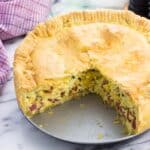
R says
Wonderful,Wonderful. I am the only non Italian in the family. But I was taught be Ferri’s, Sepes, ,Agnoles. But again its Auntie June can you make the meatballs. Love your recipe’s. Thanks, you are my Hero!!!(I am called,by my middle name.
Elaine Ferri says
I do appreciate your recipe. Made my recipe that is close to mine. After going throght pandemic I was looking for what I use to make after finnbaking cookies I hd forgot what is is called and my daughter said Mom that’s PizzaRustica. She hD. So ThNk you for your wonderful dish. God Bless
Jocelyn says
My MIL always made an "Easter pie" for all of the holidays, however she passed in 2020. I found this recipe late 2021 and surprised my s/o with it for Christmas. I switched the meat and greens to ham and spinach, like she used, along with adding bell pepper (she used diff colors depending on the holiday).
My s/o and kids love it and ask/practically beg for it regularly. Thank you for helping me keep her tradition (and memory) alive!
Alyssa says
You're very welcome, Jocelyn! Thank you for sharing, it warms my heart that this recipe could help you and your family keep a special tradition going. I love her take with changing the pepper colors!
DJ Costello says
A wonderful recipe for an Italian favorite. The detailed instructions are excellent.
Alyssa says
Thank you, I'm so glad you like this post, DJ!
Allynne says
An Italian classic!
Alyssa says
Sure is!